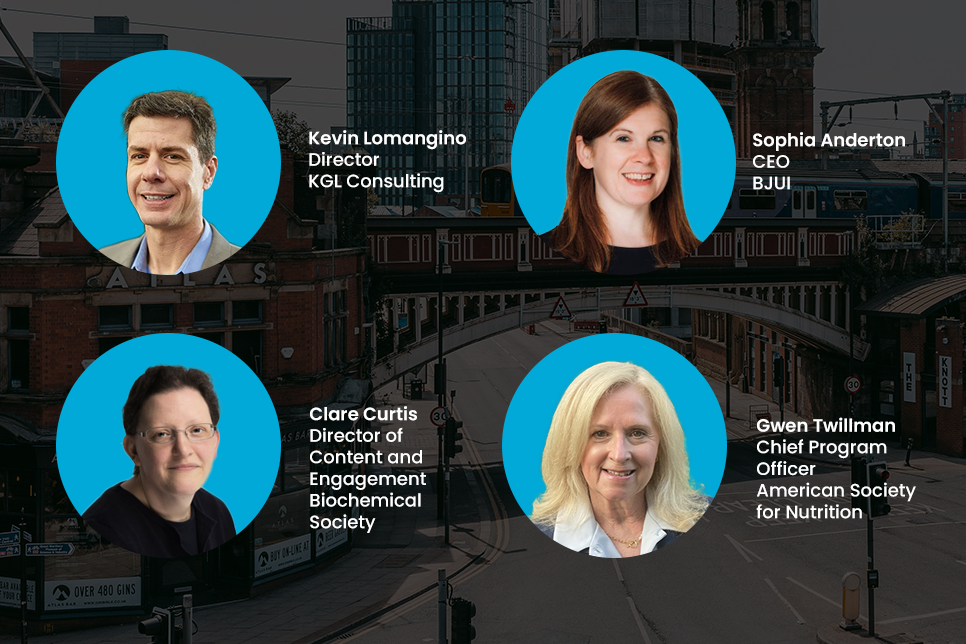Blog post
Reader Engagement Is Central to Author Experience
6 Feb 2024

First posted on the ORIGINal Thoughts Blog
By:
Ginny Herbert (she/her)
Associate Publisher, AIP Publishing
MBA Candidate, Carnegie Mellon University
LinkedIn: https://www.linkedin.com/in/ginnyherbert/
Take Home Points:
- While the open access model has shifted publishers’ focus from institutions and the readership data that drove institutional subscriptions to researchers themselves and metrics such as submission and publication volume, prioritizing reader engagement is still vital to our role as information disseminators and our ability to appropriately serve researchers.
- Reader engagement strategies are plentiful and offer varied efficacy, so before you embark on employing them at your organization, get specific about what you’re hoping to achieve—generating more citations from a specific research community will require a different strategy and key performance indicators than growing your policymaker readership.
- Partner with marketing colleagues and authors. Marketers are extremely skilled at creating and executing engagement strategies, and no one cares more about readership than your authors. Leveraging their expertise and intrinsic motivation can yield better results.
The shift from the subscription model to open access—and the corresponding shift in the parties we call customers from institutions to authors—has translated into an industry obsession with author experience: Industry conferences are chockfull of panels on engaging authors; publishers are thinking more critically about their submission systems, sometimes even investing in homegrown models à la Frontiers and Hindawi; and commercial and society publishers alike are building their organizational strategies around content acquisition, or systematic relationship management that resembles sales and marketing more so than traditional editorial.
Our data dashboards have transformed right along with us. For many of us, gone are the days of monitoring downloads per article or being singularly focused on citation metrics; instead, we pore over submissions, publications, and time-to-decision. So, in 2024, in a world where author centricity is championed as the most crucial component of competitive advantage, who cares about reader engagement?
Your authors certainly do.
Per the most recent Ithaka S+R US Faculty Survey, the top three factors influencing researchers’ publication decisions were topical relevance, circulation, and academic reputation—that is, researchers want to publish in journals that are relevant to their work and are read and cited by their peers. While this US Faculty Survey excludes some response options that are typically championed as key to author experience, such as time-to-publication or the quality of prior experiences with the editorial team, surveys done by Taylor & Francis, Editage, and Springer Nature do include those factors and still echo Ithaka S+R’s results, with relevance, reputation, and readership consistently outranking time to publication, positive experience with editors, the ability to publish open access, and the quality of journal websites.
As publishers, the importance of engaging readers to adequately serve authors should come as no surprise. If you look up “academic publishing” on Wikipedia, the industry is described as a “subfield of publishing that distributes academic research and scholarship”—distribution is the name of the game. As publication volumes grow, the task of effectively disseminating the work with which researchers trust us only becomes more challenging, and the large number and varied efficacy of reader engagement strategies just increases that complexity. How do you identify strategies to cut through the noise instead of contributing to it?
While the answer to that question is far too nuanced and organizationally dependent for a blog post to articulate, I’ve listed four recommendations below for creating a reader-engagement strategy tailored to the communities that you serve.
- Use the SMART goal structure to create a reader engagement strategy that aligns with your organization’s objectives:
- Specific: Be specific about the readers you want to attract. Do you want to reach a specific scholarly community, early-career researchers, policymakers, practitioners, science teachers, someone else entirely? Different audiences will have different information-consumption habits and engagement barriers—for example, while I can read open access articles on the molecular mechanisms of HPV, I certainly don’t understand any of it—so starting off with a strong understanding of the people you want to connect with is key for investing in appropriate strategies. If you’re not sure what the answer is to this, look to your research community and your organization’s ethos.
- Measurable: Establish measurement criteria tailored to your target audiences so that you know whether your strategies are working. If you’re interested in reaching more policymakers, you might choose to track the number of policy citations that your papers receive per Altmetric; if you’d like to build more prominence in a specific scientific community, you might track citations from several key journals.
- Attainable: Ensure your objectives are attainable. If you want to, for example, attract 500,000 new readers, make sure that there are actually 500,000 researchers working on relevant topics to enable that growth. It can be tempting to use a financial analysis or arbitrary round numbers as the foundation for objectives setting, but starting with calculating the market size and identifying citation norms within the relevant disciplines using a bibliographic database such as Web of Science or Dimensions will result in more grounded goals.
- Relevant: Why does your publication—or your organization more generally—exist? Podcasts, plain language summaries, policy highlights, and mass market articles can certainly increase engagement, but will they actually do so in a way that aligns with the reason you publish papers to begin with? Take a beat to think about whether your engagement objectives and the strategies you’re using to execute them fit within the context of your greater mission.
- Time-bound: Ensure your objectives are time-bound, and specifically that they’re realistic within the timeframe you’ve prescribed. Traditional readership metrics such as Journal Impact Factor lag, so you might not see the fruits of your labor for several years. Creating shorter-term proof points can help you stay motivated and prevent you from overinvesting in a strategy that isn’t working.
- Lean on the intelligence of the marketing community, whether it be bringing your marketing colleagues into editorial meetings, hiring a consultant, or ingesting resources created by marketing thought leaders. By definition, marketing is attracting an audience to your products, and reaching more readers is doing just that—attracting an audience (readers) to your products (journal articles). Furthermore, marketing technology both within scholarly communication and in the broader environment has exploded, particularly with the advent of artificial intelligence (AI). Marketers are well practiced in strategically segmenting audiences, building out engagement roadmaps, identifying the most appropriate marketing technology for an organization, executing campaigns, and establishing well-suited metrics for measuring their efficacy; so instead of reinventing the wheel or following the exact same blueprint as your direct competitors, utilize industry-agnostic marketing expertise.
- Partner with your authors. No one wants a paper to be well read and well cited more than its authors do, and some publishers actually offer reader engagement mechanisms such as professionally made video abstracts as a paid service, so if there are reader engagement tactics that you’re keen to try that require some level of author participation, such as a plain language description of the abstract to pass along to your marketing team, don’t be afraid to ask for it.
- Resist the urge to do everything. Resources are finite (and for many organizations, increasingly scarce), and you don’t need to start a podcast, hire a social media manager, and introduce a slew of new author services to increase readership. Instead, use the tips above to work smarter, not harder and avoid stretching your organization thin by trying too many strategies at once.
References:
- The Problem at the Heart of Public Access: https://scholarlykitchen.sspnet.org/2023/12/05/problem-heart-public-access/
- https://www.springernature.com/gp/snapp
- https://sr.ithaka.org/wp-content/uploads/2022/07/SR-Report-US-Faculty-Survey-2021-07142022.pdf
Origin Editorial is now part of KnowledgeWorks Global Ltd., the industry leader in editorial, production, online hosting, and transformative services for every stage of the content lifecycle. We are your source for society services, market analysis, intelligent automation, digital delivery, and more. Email us at info@kwglobal.com.
Related Posts

Building Resilient Publishing Programs: a Conversation with Three Society Publishers

Connection is the Heart of Association Membership




